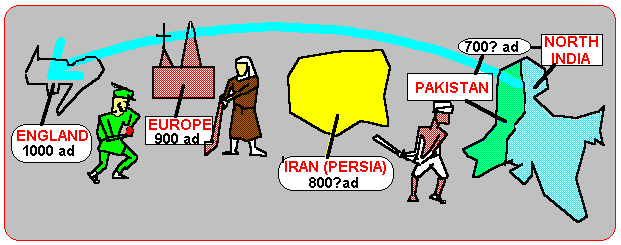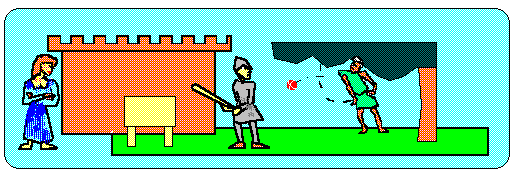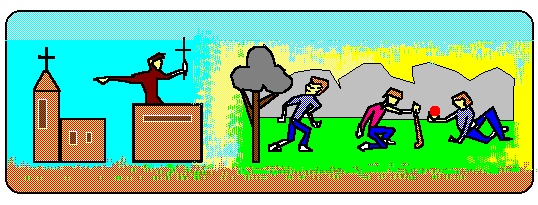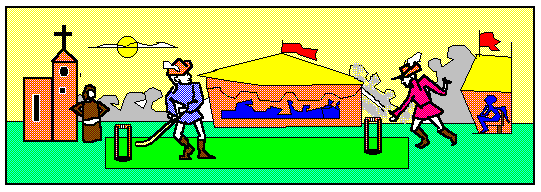Origins of Cricket--- 700 to 1000 AD

The latest thinking on the origins of cricket is that it may have developed out of ancient bat-and-ball games from the Greater Punjab ("Doab") region of the Indian subcontinent straddling North India and Pakistan, which travelled through Persia by the 8th century or earlier. In this, cricket could have behaved like two other imports into Europe from the Indian subcontinent certainly did, at about the same time--- Chess, the board game of the Indian warriors which became the Persian "shatranj" from the Indian "chaturanga", and travelled via Constantinople into Europe...and the nomadic Gypsies who wandered away from the Indian deserts through Turkey into Eastern Europe, arriving there by the 10th century...
Team sports were, of course, not new to Europe. Team "ball" games had developed there since ancient times. The Greeks even played field hockey which they had learned from Egypt, and a throwing/fielding game called ephedrismos which used a wicket, or stick, as a target for a cricket-ball-sized ball. The Romans, too, played a number of ball games....their sports looked like today's rugby, soccer and handball. What came in from the East was the "bat", i.e. a stick designed to hit an object like a ball or similar projectile, so it could be fielded.
It is the Bat, the old "danda" of South Asia, that marks the beginning of early cricket.
In the 8th century, the monk Eustatius Cardonius was demonstrating a new bat-and-ball sport he had picked up from further east, to a conclave of cardinals in Florence, Italy. By the 9th century, bat-and-ball games looking somewhat like cricket were being played in Italy, and also in Spain and Portugal. The Church in Europe seems to have taken the lead in sponsoring these bat-and-ball sporting activities on their monastery lands, as part of community-wide celebrations following church services....perhaps the beginning of "Sunday afternoon cricket" !
As the Church expanded into the British Isles, these sporting activities entered Ireland and then Britain. They were soon integrated into these rural communities, becoming part of Christian life in those places by about 1000 AD.
CRICKET IN ENGLAND : 1000 to 1300 AD

When the Normans conquered England in 1066, they adapted the Saxon bat-and-ball sport into their own lawn-based feudal recreations....and, in the process, created a new kind of sport, which they apparently called "creagh" or "cricke".
Joseph of Exeter, in 1183, gives the first complete description of this co-ed community activity. A ball is thrown at (and hit by) a batter wielding a staff which looks like today's baseball bat...the batter protects a piece of wood, perhaps a log or tree-stump, resting on a gate-like stand(could this be the origin of the term "stumps" in modern cricket?)...fielders are positioned all around... This sport has clearly been going on for some time, and Joseph of Exeter calls it a "merrye" weekend recreation.
Geoffrey Chaucer, in his Canterbury Tales, also mentions "cricke" being played in the 12th and 13th centuries...and King Edward II's household budget even refers to payments made for a "cricke" coach!
CRICKET BANNED IN ENGLAND:1300-1500 AD

Evidently the British barons and monarchs of the time took a dim view of a sport that occupied summer weekends. They preferred that yeomen spend that time practicing archery...because it was that assiduous practice every weekend with the fabled longbow that had brought victory to to the English in their European forays, and this was a military advantage the English were loth to relinquish. Richard II, in fact, seems to have banned all ball games in favor of archery practice. It was only after gunpowder eclipsed the legendary skills of the longbowmen that the restrictions on cricket began to be relaxed.
Not until the 16th century do we again hear of cricket....but the sport must have existed through that time, if only as a clandestine activity.
Indeed, it is rumored that the "outlaws" of the day made the best cricketers, and one Robert Locksley (better known to us as Robin Hood) may have also been a fine cricketer of this era! If so, the feudal lords would have had a very good reason to ban "cricke"...and the story, although perhaps apocryphal, may tell us something of why it did survive.
CRICKET'S SECRET REVIVAL:1500-1600 AD

The 16th and 17th centuries saw cricket being described, played and mentioned....indeed, the modern name of the game, i.e. crickett or crickette, is dated from those times. No longer is there talk of fines, imprisonments or confiscation of lands, or equipment.....those penalties, if they had ever been enforced, are no longer mentioned.
The nature of the game had also changed a bit by 1500 AD.
The 12th century baseball-type bat was replaced by crooked bats, shaped like oversized hockey sticks. And now there were TWO two-stick wickets, each topped by a single oversized "bail", twenty-two yards apart from each other...a distance that is to prevail for 500 years! Each set of "wickets" was constructed over a hole into which the bat had to be "popped" by a runner before a fielder could "pop" the ball in it...from this comes the modern expression, "popping crease".
From the 1500s to the late 1800s,The pitcher/bowler typically threw under-arm, although round- and even over-arm throwing was employed. In the 1500s, there were no "boundaries"; runs (called "notches" then) were scored by running--- between the bases.
Fielding formations, through the 1600s and even the 1700s, were "elongated" compared to today's cricket. There were fewer square fielders like midwicket or cover, more "long" ones like long stop, long on or long off(including "backstops" to cover for wicket-keepers who were not as well-protected as today!)
Scoring rates were low in the 1500s, because pitchers/bowlers were able to use the uneven grounds of those days to devastating effect---trick bounces, called "shooters", were a common feature. In fact, "pitching the wickets" (from where we get today's term "pitch" to describe the ground beween the sticks) was considered quite an art...to have the right bumps and soft spots to throw at could be a key to pitching/bowling success in those days!
All this would suggest a popular game, with considerable room for entertainment and strategy. However, "crickett(e)" was considered such a disreputable activity that only idlers, gamblers and dissolute characters would be seen as playing it....Moral tomes were issued, dire threats of damnation were circulated, and church pulpits echoed with vitriolic denunciations of the sport. Indeed, the years during which cricket had been an "illegal" activity had left its mark on the pastime, and many of those who had continued playing in secret did have less than impeccable moral antecendents. Still, more and more people were playing "crickett" every year, and the Church's protests increasingly fell on deaf years.
CRICKET GOES PUBLIC: 1600-1700 AD

When Oliver Cromwell was accused in the 1650s of being a "secret cricketter", the Father of the English Republic indignantly denied any connection with the sport. His supporters, the Puritans, were especially opposed to cricket, and thundered against it from their pulpits.
Cricket continued to be played, of course, but not in London or the main cities....it was exiled to the countryside, where it drew the attention of those other exiles, the royalist Cavaliers, the "gentlemen" who had suported the monarchy and were biding their time until the Puritan experiment with a non-monarchical Republic had failed.
This happened when the Restoration of 1688 brought the monarchy back to England, swept the Puritans away, and brought back the Cavaliers into power. Cricket came back with them from exile, and at last acquired a metropolitan respectability of sorts. The Cavaliers were now cricket's official patrons, and publicly supported and sponsored the game. Certainly, after this time, more and more cricket is heard of; the protests of the Church grow increasingly plaintive, and finally cease altogether. It appears that, by 1700, cricket is finally there to stay.
THE VIEW BEYOND 1700

Cricket, however, still has a long way to go, after 1700.
It is, at this time, a very rowdy sport...riots and mayhem following cricket matches are not uncommon, and a great deal of money is being squandered in side bets, win-or-lose prizes, and the like.
Unfortunately, the "sponsors" of cricket, the post-Cavaliers, are aiding and abetting the mayhem by their profligacy in throwing money and liquor around cricket venues.
The Church of those times may very well have had a point.
It took another 80 years for the "gentlemen" of the day to agree on a set of rules and finally, in 1789, publish the Laws of Cricket which marks the dawn of "modern cricket"...the cricket that we know, play and are used to...which still govern the sport today.
By 1700, however chaotic and rowdy the cricket matches of the day might have been, the sport is beginning to look like modern cricket. See the 1704 rules elsewhere on this Web site, and you can verify this for yourself.